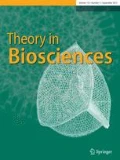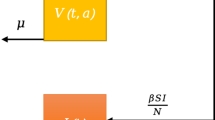Abstract
There are some analytical solutions of the Penna model of biological aging; here, we discuss the approach by Coe et al. (Phys. Rev. Lett. 89, 288103, 2002), based on the concept of self-consistent solution of a master equation representing the Penna model. The equation describes transition of the population distribution at time t to next time step (t + 1). For the steady state, the population n(a, l, t) at age a and for given genome length l becomes time-independent. In this paper we discuss the stability of the analytical solution at various ranges of the model parameters—the birth rate b or mutation rate m. The map for the transition from n(a, l, t) to the next time step population distribution n(a + 1, l, t + 1) is constructed. Then the fix point (the steady state solution) brings recovery of Coe et al. results. From the analysis of the stability matrix, the Lyapunov coefficients, indicative of the stability of the solutions, are extracted. The results lead to phase diagram of the stable solutions in the space of model parameters (b, m, h), where h is the hunt rate. With increasing birth rate b, we observe critical b 0 below which population is extinct, followed by non-zero stable single solution. Further increase in b leads to typical series of bifurcations with the cycle doubling until the chaos is reached at some b c. Limiting cases such as those leading to the logistic model are also discussed.









Similar content being viewed by others
References
Brown D, Rolhery P (1993) Models in biology: mathematics, statistics and computing. Wiley, New York
Coe JB, Mao Y (2003) Analytical solution of a generalized Penna model. Phys Rev E 67:061909
Coe JB, Mao Y (2005) Gompertz mortality law and scaling behavior of the Penna model. Phys Rev E 72:051925
Coe JB, Mao Y, Cates ME (2002) Solvable senescence model showing a mortality plateau. Phys Rev Lett 89:288103
Coe JB, Mao Y, Cates ME (2004) Solvable senescence model with positive mutations. Phys Rev E 70:021907
Magdoń MS, Maksymowicz AZ (1999) Penna model in migrating population—effect of environmental factor and genetics. Physica A 273:182
Maksymowicz AZ (1999) Influence of variations in threshold of bad mutations on age structure of the population. Physica A 273:150
Moss de Oliveira S, de Oliveira PMC, Stauffer D (1999) Evolution, money, war and computers. Teubner, Stuttgart-Leipzig
Penna TJP (1995) A bit string model for biological aging. J Stat Phys 78:1629
Sitarz M, Maksymowicz AZ (2005) Divergent evolution paths of different genetic families in the Penna model. Int J Mod Phys C 16:1917
Acknowledgments
This work was partly supported by Agricultural University in Kraków. Some of the computer simulations were carried out at the Academic Computer Center CYFRONET-KRAKÓW.
Author information
Authors and Affiliations
Corresponding author
Rights and permissions
About this article
Cite this article
Magdoń-Maksymowicz, M.S. Stability of the analytical solution of Penna model of biological aging. Theory Biosci. 127, 335–342 (2008). https://doi.org/10.1007/s12064-008-0051-y
Received:
Accepted:
Published:
Issue Date:
DOI: https://doi.org/10.1007/s12064-008-0051-y




